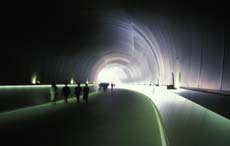Complexification and related strategies

The cry for a liberated, more conscious relation to fantasy and spaces

Out of unreflective darkness into the light -- the approach tunnel to the Miho Museum near Shigaraki, Japan

Aware celebration of the complexities of the ordinary
We need to inhabit our places with more lived awareness of their complex dimensions and internal tensions. Suggesting this should remind us of the strategies of unmasking and defamiliarization that have been proposed in Marx-influenced theories and acted out in modernist art. Those strategies work to render fluid what is taken as static, and to show as socially constructed what is taken as naturally given. The theories and art works try to open up ideological blinders and remove false consciousness.
There are many similarities, since the strategy of self-aware complexification that I have been describing shares with strategies of unmasking the aim of a more active self-relation for the individual and for the community. Still the strategy of complexifying is broader, and not so immediately political. The aim of the strategy of complexity is to undo the illusions of simple immediacy, and that is a broader category than the notions of ideology and false consciousness. Complexity does always mean less isolation, more connections and mediations, but immediacy is not always false consciousness in the Marxist sense. Stan Allen urges that "the radical gesture today is not to unmask the simulacrum as a lie, but rather to require the simulacrum, against expectation, to function as the real." (Allen 1995, 53-54) The tactics I suggest for themed places and suburban sprawl do ask them to "function as the real," that is, to show themselves as in fact more complex places than their official self-definition prescribes. This both reveals and increases their complexity. [Objection!]- [Return to "strategies"]
- [Nearby: Complexity outline -- Strategies of complexification -- Serial simplicities ]